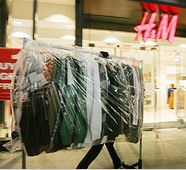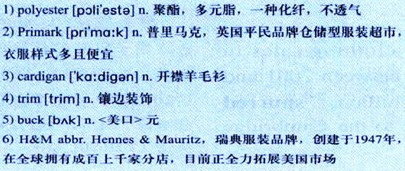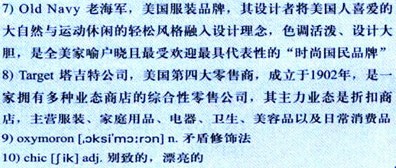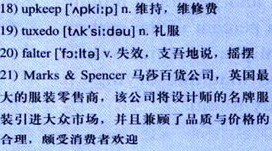Can 1)Polyester Save the World 透视“快餐式”服装产业
文字难度:★★★
Josephine Copeland and her 20-year-old daughter, Jo, visited 2)Primark at the Peacock Center Mall in the London suburbs, to buy presents for friends, but ended up loaded with clothes for themselves: boots, a 3)cardigan, a festive blouse, and a long silver coat with synthetic fur 4)trim, which cost £12 but looks like a million 5)bucks. “If it falls apart, you just toss it away!” said Jo, proudly wearing her new purchase.
约瑟芬·科普兰和她那20岁大的女儿乔在伦敦市郊的“孔雀购物中心”里的普里马克商店为朋友们购买礼物,但是最终她们却为自己买了许多衣物——靴子,一件开襟羊毛衫,一件出席宴会时穿的宽松短衫,一件带有人造皮革镶边装饰的银色长外套。这些东西只花了12英磅(约182元),但是看起来仿佛花了大把钞票。“如果这些衣服裂缝了,你直接把它们扔掉就是了!”乔说道。她自豪地穿着新购买的衣物。
 Environmentally, that is more and more of a problem.
Environmentally, that is more and more of a problem.
从环境的角度来看,这是一个越来越严重的问题。
With rainbow piles of sweaters and T-shirts that often cost less than a sandwich, stores like Primark are leaders in the quick-growing “fast fashion” industry, selling cheap garments that can be used and discarded without a second thought. Consumers, especially teenagers, love the concept, pioneered also by stores like 6)H&M internationally, and by 7)Old Navy and 8)Target in the United States, since it allows them to shift styles with speed on a low budget.
一叠叠五颜六色的毛衣和T恤的价格甚至抵不上一个三明治。像普里马克这样的品牌店是迅速发展起来的“快餐式时尚”产业的先锋,他们销售的那些便宜的衣服可以用来穿一穿,然后不假思索地扔掉。消费者,尤其是青少年,非常喜欢这种着装概念,因为它让青少年可以用很小的支出迅速转换着装风格,从而紧随时代潮流。引导这种着装潮流的还有H&M国际连锁店、美国的“老海军”品牌店和“塔吉特”百货商店。
But clothes—and fast clothes in particular—are a large and worsening source of carbon emissions contributing to global warming, because of both how they are produced and cared for. This is the conclusion in a new report from researchers at Cambridge University, titled Well Dressed?
然而服装——尤其是那种快餐式的服装——是导致大量二氧化碳释放的一个越来越重要的因素,因为这些衣服在生产和以后的处理中都会产生大量的二氧化碳,而二氧化碳直接导致全球变暖。这是剑桥大学研究员们最近发表的一篇题为《穿着讲究?》的报告得出的结论。
The global textile industry must become ecoconscious, the report concludes. The document explores ways of how to develop a more “sustainable clothing” industry—seamingly, an 9)oxymoron, in a world where fashions change every few months.
报告指出,全球纺织业必须树立环保意识。它探索了如何发展一个更能“持续发展的服装产业”的途径——这对于每隔几个月变一次潮流的社会来说,似乎是一个自相矛盾的说法。
“People nowadays think a lot about green travel and green food. But I think we are a long way from there in terms of clothes. People are mad about those stores.” Said Sally Neild, 44, dressed in casual 10)chic jeans and boots, as she pondered such alien concepts, shopping bags in hand.
“现在的人很关注绿色旅游和绿色食品。但我想,在绿色服装方面,我们还有很长的路要走。人们太痴迷于那些时尚服装店了。”44岁的萨莉·尼尔德思考着这些陌生的观念说道。她穿着随意而别致的牛仔裤和靴子,手里拎着购物袋。
It is hard to imagine how customers who rush after trends, or the stores that serve them, will respond to the report’s suggestions, namely, that people lease clothes and return them at the end of one month or season, so the garments can be lent again to someone else like library books and that they buy more expensive and durable clothing, which can be worn for years.
很难想象那些追逐潮流的消费者,或者那些服务于他们的商店看到剑桥大学这篇报告里的建议后会是什么反映。报告建议:人们可以从商店里租借便宜而时尚的衣服,一个月或者一个季度后再归还它们,这样,衣服就可以像图书馆的书那样再租给其他人,而人们就可以买较昂贵而耐穿的衣服,那些衣服可以穿上好几年。
In terms of care, the report highlights the benefits of synthetic fabrics that require less hot water to wash and less 11)ironing. It suggests that consumers air-dry clothes and throw away their 12)tumble dryers, which require huge amounts of energy.
至于服装的护理,报告强调了合成纤维织物的优点——不需要太多热水来洗涤,晾干后也不太需要熨烫。报告建议,消费者自然风干衣物,并且扔掉他们极其耗费能源的干燥机。
Consumers spend more than $1 trillion a year on clothing and textiles—an estimated one-third of that in Western Europe, another third in North America, and about a quarter in Asia. In many places, cheap, readily disposable clothes have displaced 13)hand-me-downs as the mainstay of dressing.
每年,消费者花在服装和纺织品上的钱超过一万亿美元,其中西欧的服装消费额估计占三分之一,北美洲占三分之一,亚洲大约占四分之一。在许多地方,廉价且稍穿即弃的衣服已取代了那些一穿再穿的旧衣服,成为时装的主流。
“My mother had the same wardrobe her entire life,” Ms. Neild said. “For my daughter, styles change every six months, and you need to keep up.”
“我母亲一个衣柜的衣服就穿了一辈子。”尼尔德小姐说,“对于我女儿来说,潮流每隔六个月就发生变化,你必须跟上步伐。”
As a result, women’s clothing sales in Britain rose by 21 percent between 2001 and 2005 alone to about £24 billion, 14)spurred by lower prices, according to the Cambridge report.
根据剑桥大学的报告,由于服装价格降低的刺激,在英国,从2001年到2005年,女士服装销售额增长了21%,达到240亿英镑(约3650亿元)。
And while many people have grown accustomed to recycling cans, bottles and newspapers, used clothes are generally thrown away. “In a wealthy society, clothing and textiles are bought as much for fashion as for function,” the report says, and that means that clothes are replaced “before the end of their natural life.”
当很多人已经习惯了回收旧罐头、旧瓶子和旧报纸时,他们却通常会扔掉旧衣服。报告还提到,“在一个富有的社会里,购买衣服和纺织品不但是为了实际穿着的需要,而且同等程度上是为了追赶潮流的需要。”这就意味着,衣服“在它们的自然寿命结束以前”就被更换了。
Dr. Julian Allwood, who led a team of environmental researchers in conducting the report, noted in an interview, that it is now easier for British consumers to toss unwanted clothes than to take them to a recycling center, and easier to throw clothes into the 15)hamper for a quick machine wash and dry than to sponge off stains.
剑桥大学的这篇报告由朱利安·奥尔伍德博士带领一个环境研究员组成的小组完成,他在一次采访中特别提到,现在对于英国的消费者来说,把一些不想要的衣服扔掉比送到回收中心更容易,把衣服扔进高速洗衣机清洗,然后晾干,比自己动手费劲处理衣服上的污点更容易。
“Morally, we know more sustainable clothing is the right thing to do, but we are more and more convinced that commercially it is the right thing as well,” Mr. Barry said. In fact, marketing the “green” value of clothing, even if it costs a bit more, may provide an advantage over competitors.
“从道义上讲,我们知道,生产一些更符合可持续发展要求的服装是正确的做法,但我们越来越相信,它从商业角度来看也是正确的。”巴里先生说。事实上,推广服装业的“绿色”环保理念,即使成本略高一些,也可能是一个超过竞争对手的优势。
Part of the problem is that neither manufacturers nor customers understand much about how and when clothing purchases degrade the environment, since these can occur anywhere from the harvest of cotton or the manufacture of synthetic fibers to how—and how often—the garment must be washed.
还有一个问题就是,制造商和消费者们都不大清楚服装购买行为如何以及何时导致了环境的恶化。因为这可以发生在任何环节,从棉花的收获、合成纤维制品的生产,到人们洗衣服的过程以及洗衣服的次数。
In their efforts to buy green, customers tend to focus on packaging and chemicals, issues that do not 16)factor in with clothing. Likewise, they purchase “natural” fibers like cotton, believing they are good for the environment. But that is not always the case: while so-called organic cotton is exemplary in the way it avoids pesticides, cotton garments 17)squander energy because they must be washed frequently at high temperatures, and generally require tumble-drying and ironing. Sixty percent of the carbon emissions generated by a simple cotton T-shirt comes from the 25 washes and machine dryings it will require, the Cambridge study found.
消费者在努力追求“绿色消费”时,倾向于关注包装和化学品方面的问题,这种思维方式对于服装业是不适用的。同样,他们购买“自然”的纤维,比如棉花,认为棉花对环境有利。而事实并不完全如此:虽然所谓的有机棉因无需使用杀虫剂而受到推崇,但因为棉制服装必须在高温下反复清洗,并且一般都需要甩干和熨烫,所以它们浪费能源。剑桥大学研究发现,一件简单的棉制T恤的60%的二氧化碳排放量,来自于它所经过的25次洗涤和机器烘干。
A polyester blouse, by contrast, takes more energy to make, since synthetic fabric comes from materials like wood and oil. But the 18)upkeep is far more fuel-efficient, since polyester cleans more easily and dries faster.
相比之下,一件含聚酯成分的罩衫在制作过程中需要消耗更多能源,因为合成纤维是从树木和石油这样的材料中提炼出来的。但是,由于聚酯衣料容易洗、干得快,所以在维护方面更节能。
Over a lifetime, a polyester blouse uses less energy than a cotton T-shirt.
在整个使用寿命中,一件含聚酯成分的罩衫要比一件棉制T恤更节约能源。
The report suggests that retailers could begin to lease clothes for a season (just as wedding stores rent 19)tuxedos) or buy back old clothes from customers at a discount, for recycling.
报告建议,服装行业的零售商可以先试着用一个季度来租赁服装(就如同婚纱店出租男士晚礼服那样),或者从顾客手中折价买回旧衣服,以循环再利用。
But experiments along these lines have 20)faltered. A decade ago, Hanna Andersson, an eco-conscious American clothing company, tried offering mail-order customers 20% credit toward new purchases if they sent back their used garments. This “hannadowns” program was canceled after two years.
但走这些路子的实验曾经失败过。十年前,汉那·安德森——一个具有环保意识的美国服装公司尝试向再次购买产品的邮购顾客提供20%的优惠,前提是他们必须寄回他们的旧衣服。但这个“汉那循环”计划实行了两年就被取消了。
To cut back the use of carbons and make fashion truly sustainable, shoppers will have “to own less, to have less stuff,” Dr. Allwood said. “And that is a very hard sell.”
要降低二氧化碳耗费量,使时尚真正可持续发展,购物者必须“少占有,少藏衣。”奥尔伍德博士说,“在顾客中推广这种理念确实非常困难。”
And so 21)Marks & Spencer is thinking about whether its customers will be willing to change their buying habits, to pay more for less-fashionable but “sustainable” garments. After all, consumers have shown a willingness to pay more for clothes not made in 21)sweatshops, and some are unwilling to buy diamonds because of forced labor in African mines.
于是,马莎百货公司在考虑他们的顾客是否愿意改变购物习惯,多花一点钱购买不那么时尚但“符合可持续发展”的衣服。毕竟,消费者已经显示,他们愿意花较多的钱买非血汗工厂生产出来的衣服,还有一些消费者因为非洲矿山里的强迫劳动而不愿意购买钻石。







